Kliff Notes - Analysing the Cardinals' Offense
By Scott Geelan
Despite failing to win their first game of 2019, and after a slow start, Kliff Kingsbury's offense showed some tantalising glimpses of promise.
Across three quarters, the Cardinals’ new look, supposedly high powered, ‘Air Raid’ offense looked like a Typhoon being powered by an office fan. The hire of the precocious new Head Coach, Kliff Kingsbury, was supposed to consign such offensive turgidity to the previous regime. Yet after three quarters and six points, Cardinals fans may have been forgiven for thinking nothing had changed.
Suddenly, in the fourth quarter at least, a reasonably powerful combustion engine finally sprung into life. 21 points and 25 minutes of playing time later, the narrative surrounding the Cardinals and their new offense was different. Offensive turgidity may not yet be consigned to the history books, but this new offense had shown it could get up and down the field.
Upon further review, the signs are more promising yet. Whilst Kingsbury was willing to blame himself for the Cardinals early struggles, his play designs routinely created openings and opportunities for his receivers, throughout the match. On field execution was lacking however, most notably from the offensive line and from quarterback Kyler Murray.
The purpose of this article will be to analyse the Cardinals’ offense in week 1. However, first, a very brief history lesson of the Air Raid…
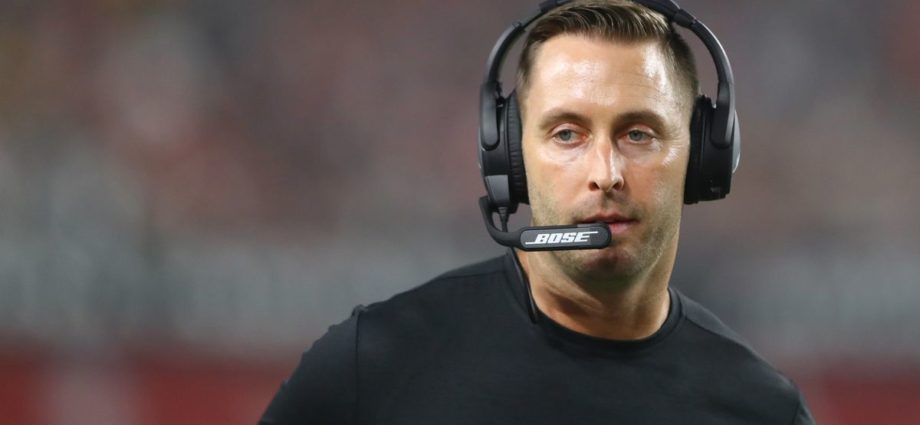
The Air Raid
The Air Raid was first created by Hal Mumme and Mike Leach during their time together at Iowa Wesleyan, Valdosta State and Kentucky in the 1990s. It has since developed into the most potent offensive idea in football and has recently sent the likes of Jared Goff, Nick Foles, Baker Mayfield, the Cardinals’ own Kyler Murray and 2018 MVP Patrick Mahomes to the NFL. Described as an idea, a mindset, a scheme and an ideology, the Air Raid produces offensive efficiency desired across the football landscape
The offense was inspired by the ideas of legendary coach Sid Gillman. The defining aspect of Gillman’s offensive philosophy was to create both vertical and horizontal stresses on a defense, whilst also including man beating concepts. The Air Raid has taken this to the extreme, stretching the area of the field utilised effectively by the offense from sideline to sideline and as far as the quarterback can throw the ball. Passing is the focus. According to Leach, his understanding of a balanced offense is one in which “the five guys who catch the ball all gain 1000 yards in the season”.
The Air Raid has developed from what was a predominantly two-back offense into one that routinely sends four wide receivers out onto the field. Leach was responsible for this development, which he begun during his time at Oklahoma and continued during his tenure as the Texas Tech Head Coach. Leach’s first success story at quarterback during his time with Texas Tech? Kliff Kingsbury.
After failing to make the grade as an NFL quarterback, Kingsbury moved into coaching. An Air Raid product as a player, Kingsbury became an Air Raid savant as a coach. He joined Dana Holgerson in his first job at Houston in 2008. Holgerson was Kingbsury’s former offensive co-ordinator under Leach at Texas Tech and was at the time carving out his own reputation as an offensive genius.
It didn’t take long for Kingsbury to carve out such a reputation for himself. After being appointed Offensive Co-ordinator at Texas A&M in 2011, he coached a certain Johnny Manziel to the Heisman Trophy. Subsequently, he was named Head Coach of his alma mater, Texas Tech. After six record breaking years, the NFL came calling.
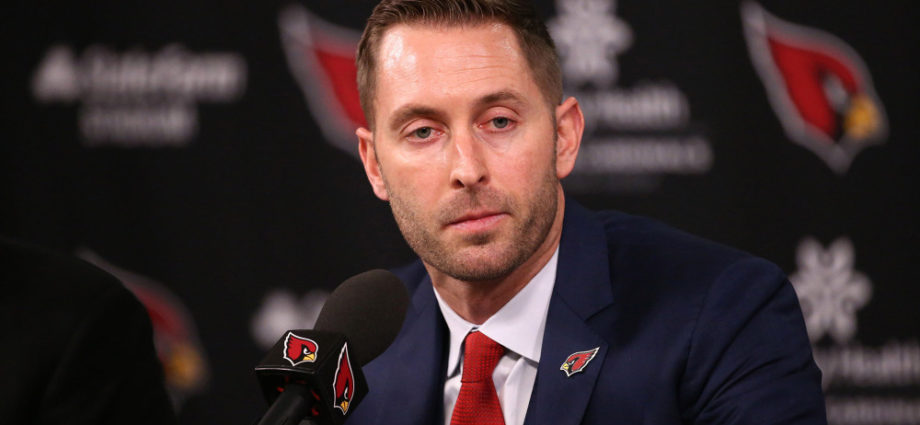
The Air Raid in Arizona
Sunday was the first time the Air Raid had been formally used in anger in the NFL. Prior to this however, there can be little doubt it has inspired or prompted an array of offensive play designs, most notably those of the Super Bowl winning Eagles and the New England Patriots.
Resultantly, many Air Raid concepts and ideas will not be new to the Cardinals’ opponents. They will certainly not have been new to former New England defensive co-ordinator and Detroit Head Coach Matt Patricia. He coached in practice against an offense that utilised many Air Raid principles and designs as well as coaching in a Super Bowl against the Philadelphia Eagles. Nevertheless, Kingsbury was able to design and call a host of plays that out-leveraged Patricia’s defense.
This was exactly why he was hired. Kingsbury wasn’t hired to bring something completely new to the NFL field. He was hired because he was seen as someone capable of harnessing concepts the NFL largely already knew and spinning them into something uniquely threatening. He was seen as someone who could call and design plays that beat NFL defenses; someone whose play-calling and designs could deliver wins in the NFL.
Whilst he was unable to achieve the latter, he has already shown he can do the former. Furthermore, the Cardinals offense already looks like it will be uniquely threatening in its personnel groupings compared to its fellow NFL offenses.
In 82 plays, 55 of them featured the Cardinals in 10 personnel (1 running back, 4 wide receivers). This was a feature of Kingsbury’s offense at Texas Tech. The rest of the NFL only called 99 plays in 10 personnel in week 1.
This grouping put Detroit in a bind and often resulted in the Lions choosing to cover Larry Fitzgerald with a safety. Fitzgerald’s usage as a pseudo-tight end in Kingsbury’s concepts will be fascinating to follow and potentially promises even greater longevity for the Cardinals’ greatest ever player.
For much of the game, even if the passes were not completed or even attempted, the Cardinals had open receivers. This extended to the Cardinals’ negative plays. Kingbury’s ability to scheme horizontal stretches as well as simply hi-lo reads was on show repeatedly and promises much if his team can start executing more successfully.
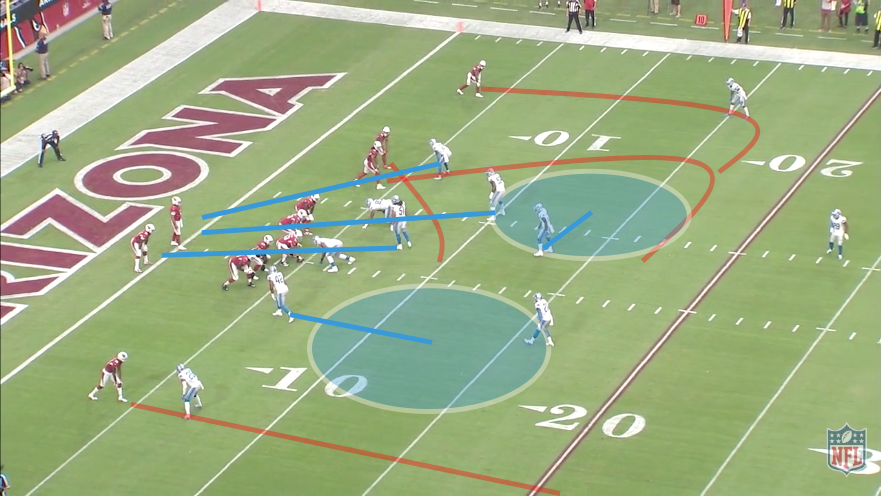
This was the play where Murray threw his interception. It should have been avoided with effective field vision and anticipation however.
Kingsbury called a follow concept to the field (top of the picture), creating a potential horizontal stretch on the underneath defenders. Furthermore, the curl route would also create a hi-lo stretch on those same underneath defenders.
The Lions actually blitzed here, leaving six players in coverage with only two underneath defenders. The hook player to the field was thoroughly outnumbered, with both in-breaking routes open behind the curl. Murray failed to identify where the blitz had come from, missing the two open receivers and throwing an interception.
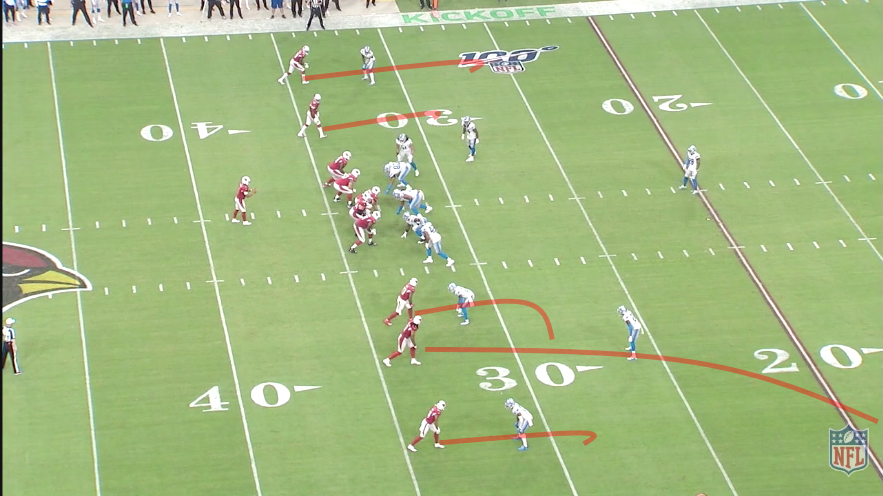
This play was rather more successful for Arizona. This design packages two Air Raid and spread staples together – all curls with a slot fade/lazy corner route. Again, the defense is both horizontally and vertically stretched.
The curls in theory sretch defenders horizontally, whilst the slot fade with the curl from the outside receiver creates a hi-lo stretch to the field. In reality, a triangle read is established to the field (bottom of the picture), with both a hi-lo and horizontal stretch in existence.
Furthermore, Kingsbury’s decision to send his pseudo-tight end Fitzgerald on the fade/lazy corner is a masterstroke; it’s a likely man coverage beater. Paired with a safety, Fitzgerald is a match-up winner.
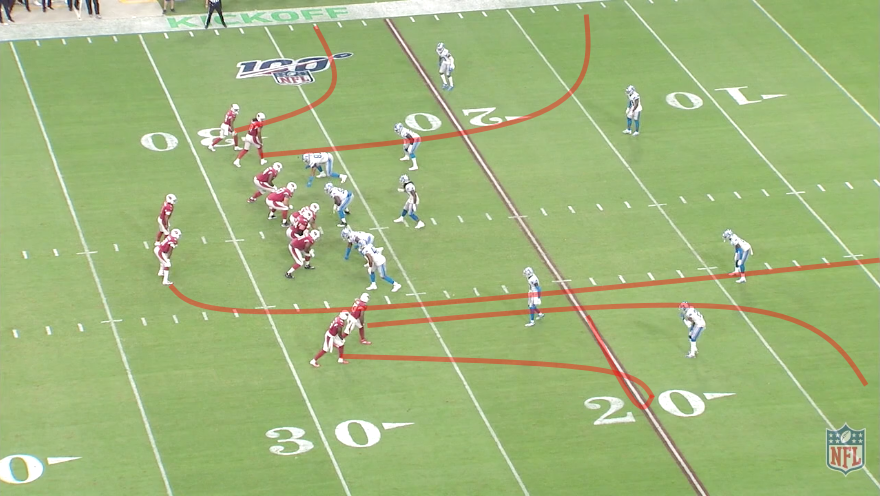
David Johnson’s touchdown was another superb design from Kingsbury. He clearly anticipated the Lions running a split field coverage as the Cardinals entered the red zone and attacked it accordingly. Every single route was designed with the intention of out-leveraging and beating the Lions’ play call.
To the boundary (top of the picture) is a smash concept featuring a quick out from the outside receiver and a corner route from Fitzgerald. This creates a hi-lo stretch on the cornerback. It could also outleverage the safety, or at least pull him away from the centre of the field.
On the other side, a similar concept is called. The inside receiver again runs the corner route, threatening in behind the corner as well as pulling the safety outside. The outside receiver runs a return route however. This still has the potential effect of creating a hi-lo stretch on the corner but it is also a likely man beater if the corner anticipates an out route.
It is in the middle of the field, as a result of all this window dressing, that Kingsbury’s master plan comes to fruition however. With the safeties pulled wide by the corner routes, the middle of the field is wide open. Just like he clearly is with Fitzgerald, Kingsbury is cognisant that David Johnson can be a match-up weapon. He is matched up essentially man -to-man with the Lions’ linebacker on the vertical route, running untouched into the end-zone. This play is a supreme cover 2 or quarter-palms beater.
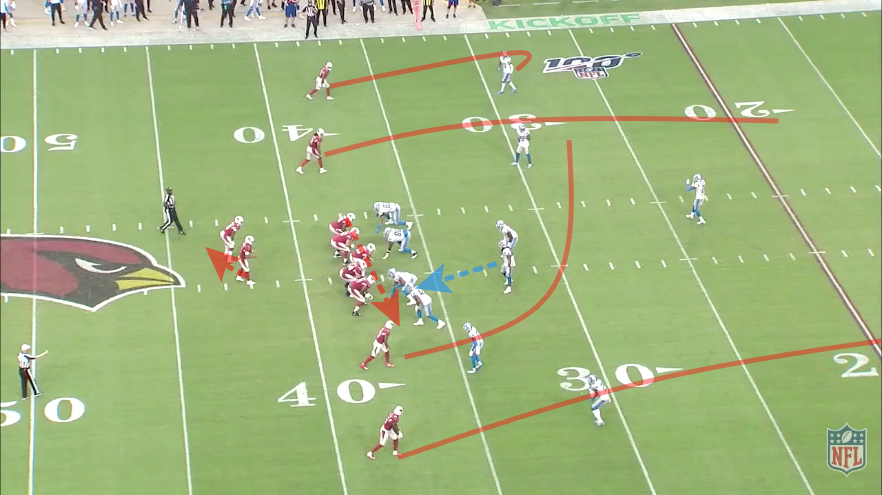
This play action design is also extremely intelligent. The Lions are in cover 3, meaning there are three deep defenders and four underdeath defenders.
To the field (top of the screen), Kingsbury calls a HOSS concept – a hitch outside a seam. This is a widely utilised cover 3 beater. The seam-flat defender (the nickel corner) is normally stretched horizontally. He has to initially account for Fitzgerald running the seam route so cannot cover the hitch on the outside.
The cornerback however, also has to account for Fitzgerald because he has the deep third and is reading the receivers 2-1. He can’t cover the hitch route underneath him as a result.
To the boundary, Kingsbury calls a vertical shot route from the outside receiver and an over route from Christian Kirk. When Kirk crosses the formation, if the Lions were playing a match-up cover 3 the seam-flat player would have carried Fitzgerald, potentially creating almost a dagger concept (vertical route paired with a dig to clear out deep defenders).
On this play, the play action call has the effect of sucking the linebackers down towards the run action. This was planned of course. Play action crossers are a staple in NFL playbooks.
The Cardinals hard run action to their right had two effects though. Not only did it suck the linebackers across and to their left, it also moved the entire defensive line. This meant that Murray had a completely unobstructed view of the field in front of him – a very useful outcome for a 5’10” quarterback. He completed the pass to Kirk who was wide open behind the linebackers.
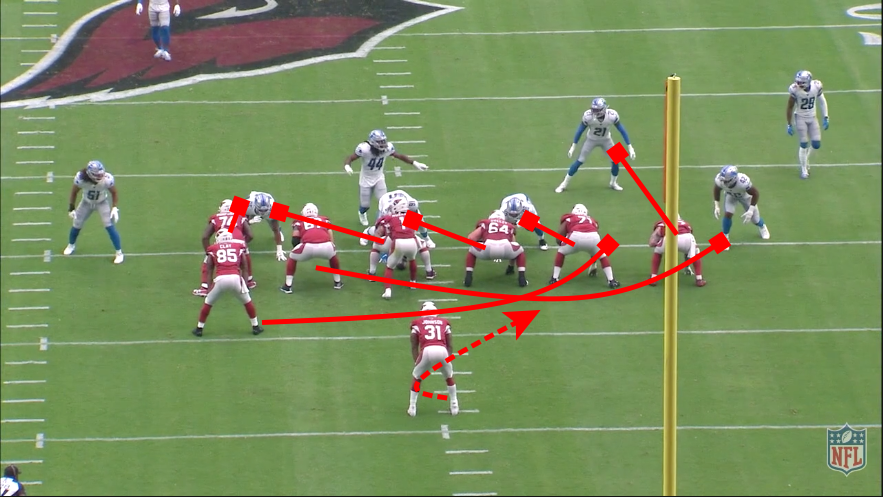
It isn’t just Kingbury’s passing plays which are well designed either. His run plays regularly feature motion to lighten the box further and confuse run fits. Air Raid teams prefer to run only when they have a very clear numbers advantage in the box.
Out of shot, a receiver is running from left to right. He crosses the formation and takes the Detroit player furthest to the right away from the play. This was by design.
The Cardinals are running a staple of the Oklahoma offense – a G-F counter run. Most of the offensive line block as if the play is going to their left. However, the left guard and the F-receiver (number 85) come across to the right hand to block. They lead the way for Johnson.
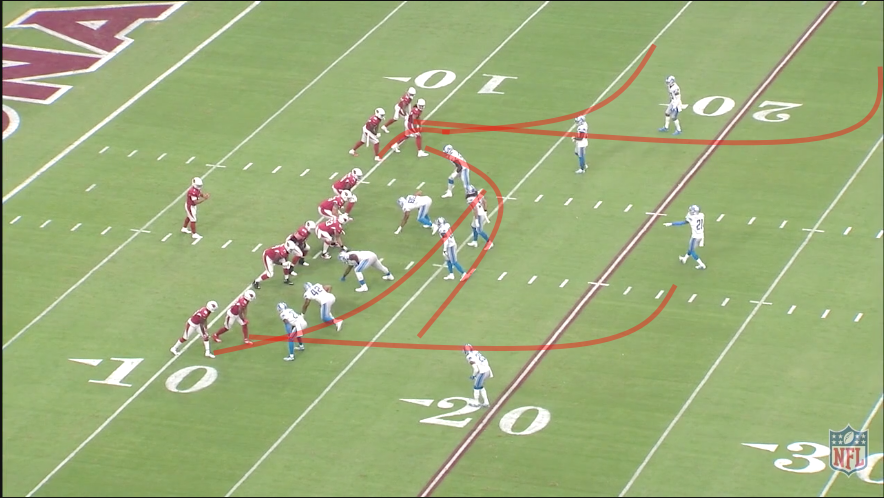
The above play is another wonderful desing by Kingsbury. This is the last play I will analyse.
Mesh is another staple of the Air Raid and was one of the first notable Air Raid plays. Here the mesh concept is created by Fitzgerald on the field side running a drag route over the top of a drag from the boundary side. Fitzgerald, as the Y receiver (pseudo-tight end), sets the height of the mesh. The mesh concept, is both a man and zone beater. The receivers can run away from their defender in man coverage or settle into soft spots if facing zone coverage.
The mesh concept is packaged up with a deeper over route so as to create a shallow cross concept, a slightly newer Air Raid staple. This creates a hi-lo stretch against the underneath defenders. The receivers’ alignments on the boundary side (bottom of the screen) are selected very specifically. The over route picks the possible man cover defender on the drag, creating space for him in case this is a man coverage call. Furthermore, the tight split creates favourable inside leverage against the deep cornerback for the in-breaking route.
To the field, in addition to Fitzgerald’s drag, Kingsbury has added a smash concept (outlined above). Another hi-lo stretch is created. On this play therefore, Kingsbury packaged a mesh concept with a shallow cross with a smash concept.
Conclusion
This was just a selection of plays from the Cardinals’ clash with Detroit. What they should highlight is the brilliance of Kingsbury’s play designs. He has the ability to design plays specifically to defeat (in several ways) one type of coverage that the Cardinals predict the opposition is likely to call at certain moments. More impressively, he has the ability to package concepts together in such a way so as to create plays that can beat whatever coverage the opposition choose to run.
This should be extremely exciting for Cardinals fans. They do need Murray to get more experienced and decisive at the NFL level. Furthermore, they need an offensive line that can keep him upright and hold their blocks in the run game. If that happens, Kingsbury has the offensive ability to lead them back to the glory years they enjoyed under another offensive guru, Bruce Arians.

Scott Geelan
NFL ANALYST
SCOTT IS A LAW STUDENT AND WILL BE COVERING THE NFC WEST FOR THE TOUCHDOWN. YOU CAN ALSO FIND HIS WORK AT NINERS NATION & NOTHING BUT NINERS. HE LIVES IN BIRMINGHAM
